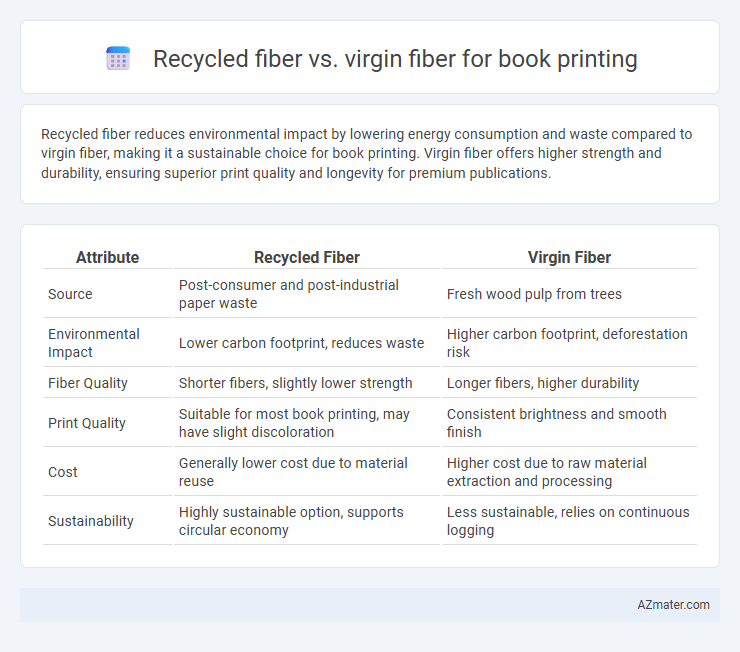Recycled fiber reduces environmental impact by lowering energy consumption and waste compared to virgin fiber, making it a sustainable choice for book printing. Virgin fiber offers higher strength and durability, ensuring superior print quality and longevity for premium publications.
Table of Comparison
| Attribute | Recycled Fiber | Virgin Fiber |
|---|---|---|
| Source | Post-consumer and post-industrial paper waste | Fresh wood pulp from trees |
| Environmental Impact | Lower carbon footprint, reduces waste | Higher carbon footprint, deforestation risk |
| Fiber Quality | Shorter fibers, slightly lower strength | Longer fibers, higher durability |
| Print Quality | Suitable for most book printing, may have slight discoloration | Consistent brightness and smooth finish |
| Cost | Generally lower cost due to material reuse | Higher cost due to raw material extraction and processing |
| Sustainability | Highly sustainable option, supports circular economy | Less sustainable, relies on continuous logging |
Introduction to Fiber Types in Book Printing
Recycled fiber in book printing is derived from previously used paper products, offering an eco-friendly alternative to virgin fiber, which comes directly from fresh wood pulp. Virgin fiber provides superior strength, brightness, and durability, essential for high-quality, long-lasting books. Choosing between recycled and virgin fibers impacts print clarity, texture, and environmental sustainability in the book production process.
Overview of Recycled Fiber
Recycled fiber for book printing is derived from post-consumer paper products, reducing the demand for virgin wood pulp and minimizing environmental impact. This fiber type often requires less energy and water during production while supporting sustainability goals through reduced deforestation and landfill waste. Advances in recycling technology ensure that recycled fibers maintain adequate strength and print quality suitable for high-volume book printing.
Overview of Virgin Fiber
Virgin fiber, derived directly from newly harvested trees, offers superior strength, brightness, and durability essential for high-quality book printing. Its long, intact fibers provide better ink absorption and print clarity, ensuring sharp text and vivid images ideal for premium publications. Compared to recycled fiber, virgin fiber yields more consistent paper quality with fewer impurities, making it preferable for archival and collectible books.
Environmental Impact Comparison
Recycled fiber significantly reduces environmental impact compared to virgin fiber in book printing by lowering energy consumption and greenhouse gas emissions by up to 40%. Using recycled fiber decreases deforestation rates, conserving biodiversity and reducing water usage by approximately 50%. The lifecycle carbon footprint of recycled fiber paper is estimated to be 28-40% lower than that of virgin fiber paper, making it a more sustainable choice for publishers.
Print Quality: Recycled vs Virgin Fiber
Virgin fiber offers superior print quality for book printing due to its longer, unbroken fibers, resulting in sharper images and crisper text. Recycled fiber, while environmentally sustainable, may contain shorter fibers and contaminants that can lead to slightly duller colors and less precise print detail. Advances in deinking and processing technologies have improved the print quality of recycled fibers, but virgin fibers remain the preferred choice for premium book printing requiring high resolution and vibrant color fidelity.
Cost Differences and Economic Feasibility
Recycled fiber for book printing significantly reduces raw material costs due to lower demand for virgin pulp, leading to decreased production expenses. Virgin fiber, while offering higher quality and durability, incurs higher costs from energy-intensive harvesting and processing, impacting overall economic feasibility. Choosing recycled fiber enhances profitability in large-volume printing projects by balancing quality with cost efficiency, making it a financially viable option for budget-conscious publishers.
Durability and Longevity of Printed Books
Virgin fiber offers superior durability and longevity for book printing due to its intact cellulose structure, which maintains strength and resistance to wear over time. Recycled fiber, while environmentally friendly, often contains shorter and broken fibers resulting from the recycling process, leading to reduced paper strength and faster degradation. Consequently, books printed on virgin fiber typically endure handling and aging better, preserving print quality and structural integrity for extended periods.
Reader Perceptions and Market Trends
Reader perceptions increasingly favor recycled fiber in book printing due to its association with environmental sustainability and eco-conscious values. Market trends show a rising demand for recycled fiber materials, driven by publishers aiming to reduce carbon footprints and appeal to green-minded consumers. Despite some concerns about quality, advancements in recycled fiber technology now deliver print clarity and durability comparable to virgin fiber, supporting a broader shift toward sustainable publishing practices.
Sustainability Certifications and Standards
Recycled fiber for book printing often meets sustainability certifications such as FSC Recycled and SFI Certified Sourcing, ensuring responsible fiber sourcing and reduced environmental impact. Virgin fiber sourced from forests with FSC or PEFC certification guarantees that paper production supports sustainable forest management and biodiversity conservation. Choosing certified recycled fiber reduces landfill waste and carbon footprint, aligning print production with global sustainability standards.
Future Outlook: The Shift Toward Eco-Friendly Printing
The future of book printing heavily favors recycled fiber over virgin fiber due to growing environmental regulations and consumer demand for sustainable products. Innovations in recycling technology enhance the quality and durability of recycled fibers, making them increasingly viable for high-quality print production. Adoption of recycled fibers significantly reduces deforestation and carbon emissions, aligning with global efforts to promote eco-friendly printing practices.

Infographic: Recycled fiber vs Virgin fiber for Book Printing
 azmater.com
azmater.com